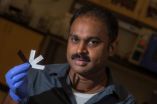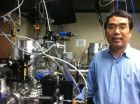(Press-News.org) HOUSTON – (Sept. 4, 2012) – Researchers at Rice University and the Université catholique de Louvain, Belgium, have developed a way to make flexible components for rechargeable lithium-ion (LI) batteries from discarded silicon.
The Rice lab of materials scientist Pulickel Ajayan created forests of nanowires from high-value but hard-to-recycle silicon. Silicon absorbs 10 times more lithium than the carbon commonly used in LI batteries, but because it expands and contracts as it charges and discharges, it breaks down quickly.
The Ajayan lab reports this week in the journal Proceedings of the National Academy of Science on its technique to make carefully arrayed nanowires encased in electrically conducting copper and ion-conducting polymer electrolyte into an anode. The material gives nanowires the space to grow and shrink as needed, which prolongs their usefulness. The electrolyte also serves as an efficient spacer between the anode and cathode.
Transforming waste into batteries should be a scalable process, said Ajayan, Rice's M. and Mary Greenwood Anderson Professor in Mechanical Engineering and Materials Science and of chemistry. The researchers hope their devices are a step toward a new generation of flexible, efficient, inexpensive batteries that can conform to any shape.
Co-lead authors Arava Leela Mohana Reddy, a Rice research scientist, and Alexandru Vlad, a former research associate at Rice and now a postdoctoral researcher at the Université catholique de Louvain, were able to pull multiple layers of the anode/electrolyte composite from a single discarded wafer. Samples of the material made at Rice look like strips of white tape or bandages.
They used an established process, colloidal nanosphere lithography, to make a silicon corrosion mask by spreading polystyrene beads suspended in liquid onto a silicon wafer. The beads on the wafer self-assembled into a hexagonal grid – and stayed put when shrunken chemically. A thin layer of gold was sprayed on and the polystyrene removed, which left a fine gold mask with evenly spaced holes on top of the wafer. "We could do this on wafers the size of a pizza in no time," Vlad said.
The mask was used in metal-assisted chemical etching, in which the silicon dissolved where it touched the metal. Over time in a chemical bath, the metal catalyst would sink into the silicon and leave millions of evenly spaced nanowires, 50 to 70 microns long, poking through the holes.
The researchers deposited a thin layer of copper on the nanowires to improve their ability to absorb lithium and then infused the array with an electrolyte that not only transported ions to the nanowires but also served as a separator between the anode and a later-applied cathode.
"Etching is not a new process," Reddy said. "But the bottleneck for battery applications had always been taking nanowires off the silicon wafer because pure, free-standing nanowires quickly crumble." The electrolyte engulfs the nanowire array in a flexible matrix and facilitates its easy removal. "We just touch it with the razor blade and it peels right off," he said. The mask is left on the unperturbed wafer to etch a new anode.
When combined with a spray-on current collector on one side and a cathode and current collector on the other, the resulting battery showed promise as it delivered 150 milliamp hours per gram with little decay over 50 charge/discharge cycles. The researchers are working to enhance those qualities and testing the anodes in standard battery configurations.
"The novelty of the approach lies in its inherent simplicity," Reddy said. "We hope the present process will provide a solution for electronics waste management by allowing a new lease on life for silicon chips."
INFORMATION:
Co-authors are intern Anakha Ajayan and graduate student Neelam Singh of Rice and professors Jean-Francois Gohy and Sorin Melinte of the Université catholique de Louvain.
The Army Research Office supported research at Rice, and the National Scientific Research Foundation, the Special Research Fund, the TINTIN project – ARC, the French Community of Belgium, the Fund for Scientific Research and the Wallonne Region (Programme ERABLE) supported research in Belgium.
This news release can be found online at http://news.rice.edu/2012/09/04/waste-silicon-gets-new-life-in-lithium-ion-batteries-at-rice-university/
Rice President David Leebron interviews Professor Pulickel Ajayan in "Campus Conversations with the President": http://news.rice.edu/2012/09/04/leebron-kicks-off-campus-conversations-with-the-president/
Read the abstract at www.pnas.org/cgi/doi/10.1073/pnas.1208638109
Follow Rice News and Media Relations via Twitter @RiceUNews
Related Materials:
Ajayan Group: http://www.owlnet.rice.edu/~rv4/Ajayan/
Images for download:
http://news.rice.edu/wp-content/uploads/2012/08/0824-anode-web.jpg
Rice University research scientist Arava Leela Mohana Reddy holds strips of anode material and a piece of waste silicon (at left). Researchers at Rice and in Belgium found a way to recycle silicon into flexible anodes for lithium-ion batteries. (Credit: Jeff Fitlow/Rice University)
http://news.rice.edu/wp-content/uploads/2012/08/Nanowire-roll-Web.jpg
The silicon/copper/polymer composite can be rolled from its silicon substrate and leave a mask in place to begin anew the process of making another anode for a lithium-ion battery. (Credit: Alexandru Vlad/Rice University)
http://news.rice.edu/wp-content/uploads/2012/08/Nanowire-mask-Web.jpg
As silicon is dissolved in a chemical bath, a gold mask sinks to the bottom, leaving silicon nanowires about 100 nanometers wide poking through the holes. Because silicon holds as much as 10 times the lithium as the anode in a typical lithium-ion battery, researchers at Rice University and in Belgium are researching ways to recycle waste silicon into functional battery components. (Credit: Alexandru Vlad/Rice University)
http://news.rice.edu/wp-content/uploads/2012/08/Nanowires-closeup-Web.jpg
Silicon nanowires poke through a gold mask on their way to becoming part of a lithium-ion battery at Rice University. The process developed at Rice and at the Université catholique de Louvain, Belgium, recycles waste silicon into functioning battery components. (Credit: Alexandru Vlad/Rice University)
Waste not, power up
Waste silicon gets new life in lithium-ion batteries at Rice University
2012-09-05
ELSE PRESS RELEASES FROM THIS DATE:
UCF researchers record world record laser pulse
2012-09-05
A University of Central Florida research team has created the world's shortest laser pulse and in the process may have given scientists a new tool to watch quantum mechanics in action – something that has been hidden from view until now.
UCF Professor Zenghu Chang from the Department of Physics and the College of Optics and Photonics, led the effort that generated a 67-attosecond pulse of extreme ultraviolet light. The results of his research are published online under Early Posting in the journal Optics Letters.
An attosecond is an incomprehensible quintillionith ...
Human impact felt on Black Sea long before industrial era
2012-09-05
When WHOI geologist Liviu Giosan first reconstructed the history of how the Danube River built its delta, he was presented with a puzzle.
In the delta's early stages of development, the river deposited its sediment within a protected bay. As the delta expanded onto the Black Sea shelf in the late Holocene and was exposed to greater waves and currents, rather than seeing the decline in sediment storage that he expected, Giosan found the opposite. The delta continued to grow. In fact, it has tripled its storage rate.
If an increase in river runoff was responsible for ...
U of M faculty find antimicrobials altering intestinal bacteria composition in swine
2012-09-05
MINNEAPOLIS/ST. PAUL (09/04/2012) — Researchers from the University of Minnesota's College of Veterinary Medicine, concerned about the use of antibiotics in animal production, have found that antimicrobial growth promoters administered to swine can alter the kind of bacteria present in the animal's intestinal track, resulting in an accelerated rate of growth and development in the animals.
Antibiotics are routinely administered to swine to treat illness and to promote larger, leaner animals.
The results of the study, conducted by Richard Isaacson, Ph.D., microbiologist ...
Little evidence of health benefits from organic foods, Stanford study finds
2012-09-05
You're in the supermarket eyeing a basket of sweet, juicy plums. You reach for the conventionally grown stone fruit, then decide to spring the extra $1/pound for its organic cousin. You figure you've just made the healthier decision by choosing the organic product — but new findings from Stanford University cast some doubt on your thinking.
"There isn't much difference between organic and conventional foods, if you're an adult and making a decision based solely on your health," said Dena Bravata, MD, MS, the senior author of a paper comparing the nutrition of organic ...
Showing the way to improved water-splitting catalysts
2012-09-05
PASADENA, Calif.—Scientists and engineers around the world are working to find a way to power the planet using solar-powered fuel cells. Such green systems would split water during daylight hours, generating hydrogen (H2) that could then be stored and used later to produce water and electricity. But robust catalysts are needed to drive the water-splitting reaction. Platinum catalysts are quite good at this, but platinum is too rare and expensive to scale up for use worldwide. Several cobalt and nickel catalysts have been suggested as cheaper alternatives, but there is still ...
Repeated exposure to traumatic images may be harmful to health
2012-09-05
Irvine, Calif., Sept. 4, 2012 – Repeated exposure to violent images from the terrorist attacks of Sept ember 11 and the Iraq War led to an increase in physical and psychological ailments in a nationally representative sample of U.S. adults, according to a new UC Irvine study.
The study sheds light on the lingering effects of "collective traumas" such as natural disasters, mass shootings and terrorist attacks. A steady diet of graphic media images may have long-lasting mental and physical health consequences, says study author Roxane Cohen Silver, UCI professor of psychology ...
A blueprint for 'affective' aggression
2012-09-05
A North Carolina State University researcher has created a roadmap to areas of the brain associated with affective aggression in mice. This roadmap may be the first step toward finding therapies for humans suffering from affective aggression disorders that lead to impulsive violent acts.
Affective aggression differs from defensive aggression or premeditated aggression used by predators, in that the role of affective aggression isn't clear and could be considered maladaptive. NC State neurobiologist Dr. Troy Ghashghaei was interested in finding the areas of the brain engaged ...
Vitamin D supplements do not improve cholesterol as previous research suggested
2012-09-05
Vitamin D has been touted for its beneficial effects on a range of human systems, from enhancing bone health to reducing the risk of developing certain cancers. But it does not improve cholesterol levels, according to a new study conducted at The Rockefeller University Hospital. A team of scientists has shown that, at least in the short term, cholesterol levels did not improve when volunteers with vitamin D deficiency received mega-doses of vitamin D. The finding is published in the journal Arteriosclerosis, Thrombosis and Vascular Biology.
The researchers, led by Manish ...
Preeclampsia poses a significant long-term health risk according to new research from Ben-Gurion U.
2012-09-05
BEER-SHEVA, ISRAEL, September 4, 2012 -- Ben-Gurion University of the Negev (BGU) researchers have determined that preeclampsia is a significant risk factor for long-term health issues, such as chronic hypertension and hospitalizations later in life. The findings from the retrospective cohort study were just published in the Journal of Maternal-Fetal and Neonatal Medicine.
Thousands of women and their babies die or get very sick from preeclampsia; it affects approximately 5 to 8 percent of all pregnancies. It is a rapidly progressive condition characterized by high blood ...
Study finds biologic therapies for rheumatoid arthritis not associated with increased cancer risk
2012-09-05
HOUSTON – Biologic therapies developed in the last decade for rheumatoid arthritis are not associated with an increased risk of cancer when compared with traditional treatments for the condition, according to new research from The University of Texas MD Anderson Cancer Center.
The study, published in The Journal of the American Medical Association (JAMA), is the largest systematic review evaluating the risk of developing any malignancy among rheumatoid arthritis patients using approved biologic response modifiers (BRMs), several of which include tumor necrosis factor ...
LAST 30 PRESS RELEASES:
Researchers develop AI Tool to identify undiagnosed Alzheimer's cases while reducing disparities
Seaweed based carbon catalyst offers metal free solution for removing antibiotics from water
Simple organic additive supercharges UV treatment of “forever chemical” PFOA
£13m NHS bill for ‘mismanagement’ of menstrual bleeds
The Lancet Psychiatry: Slow tapering plus therapy most effective strategy for stopping antidepressants, finds major meta-analysis
Body image issues in adolescence linked to depression in adulthood
Child sexual exploitation and abuse online surges amid rapid tech change; new tool for preventing abuse unveiled for path forward
Dragon-slaying saints performed green-fingered medieval miracles, new study reveals
New research identifies shared genetic factors between addiction and educational attainment
Epilepsy can lead to earlier deaths in people with intellectual disabilities, study shows
Global study suggests the underlying problems of ECT patients are often ignored
Mapping ‘dark’ regions of the genome illuminates how cells respond to their environment
ECOG-ACRIN and Caris Life Sciences unveil first findings from a multi-year collaboration to advance AI-powered multimodal tools for breast cancer recurrence risk stratification
Satellite data helps UNM researchers map massive rupture of 2025 Myanmar earthquake
Twisting Spins: Florida State University researchers explore chemical boundaries to create new magnetic material
Mayo Clinic researchers find new hope for toughest myeloma through off-the-shelf immunotherapy
Cell-free DNA Could Detect Adverse Events from Immunotherapy
American College of Cardiology announces Fuster Prevention Forum
AAN issues new guideline for the management of functional seizures
Could GLP-1 drugs affect risk of epilepsy for people with diabetes?
New circoviruses discovered in pilot whales and orcas from the North Atlantic
Study finds increase in risk of binge drinking among 12th graders who use 2 or more cannabis products
New paper-based technology could transform cancer drug testing
Opioids: clarifying the concept of safe supply to save lives
New species of tiny pumpkin toadlet discovered in Brazil highlights need for conservation in the mountain forests of Serra do Quiriri
Reciprocity matters--people were more supportive of climate policies in their country if they believed other countries were making significant efforts themselves
Stanford Medicine study shows why mRNA-based COVID-19 vaccines can cause myocarditis
Biobanking opens new windows into human evolution
Sky-high smoke
AI tips off scientists to new drug target to fight, treat mpox
[Press-News.org] Waste not, power upWaste silicon gets new life in lithium-ion batteries at Rice University



